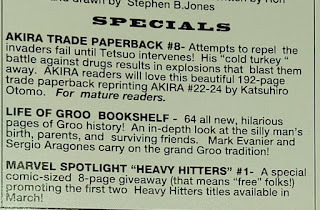Pages
- About
- Gallery
- Blog
- Reviews.
- Collections
- Timeline DATA FACTS
- Video Room
- CRITICAL WAVE
- 1992 Anime Day 0092 Con in the pocket.
- ConTanimeT 1992 October 2-4, 1992.
- Manga Mainia July 1993-
- 1993 Anime Day File 3 The Con that bit its tongue.
- ContAnimeTed October 22-24, 1993
- KISEKI Films 1993-1996
- 1994 Anime Day: FLASHBACK (Memories of Macross)
- D-CONTAMINET 14th -16th October 1994
- BSFA's Matrix
- ReConTanimeTed 3-5 NOVEMBER 1995
- 90's Fans questionaire.
- PROJECT L-CON, - L-KCon, - L-Kon, 18th. June
- PIONEER LDCE UK 1994-1998
- AnimeUK Magazine December 1991
- AnimeUK Magazines 1992
New visitors please read this Blog from Old to New using Chronoblog, the past is important!
Sunday, 29 December 2013
Lost Comic-books from the 80's Pt. 24
Star
Blazers. Written by Phil Foglio
and
illustrated by Doug Rice
- (based on
characters and situations from ' Space Battleship Yamato' credited
to Leiji Matsumoto & Yoshinobu Nishizaki ). Comico
Comics,
published in
a monthly format for a total of #1 - 4 issues, from April 1987 to
July 1987,
and #1 - 5
issues, from May 1989
to September
1989.
This
short lived transference from popular television cartoon show 'Star
Blazers', an early breakthrough in dubbed Anime that was the heavily
edited for America. Taken from 'Space
Battleship Yamato', that had an on-going storyline needing to be
shown in order.
The
Basic plot is set in the year 2199, the Earth is a radioactive
dust-bowl thanks to an Alien menace and what's left of the Human race
lives in cities deep under ground. At this time Earth scientists
have calculated that in one year the radiation will reach fatal
levels for all of Humanity, but as fate and luck would have it the
earth has a new ally who sends engine blueprints for a
faster-than-light Star-drive.
Earth
resources are pulled together and the ancient Battleship Yamato is
retro fitted and made in to a Space battleship, we then follow the
crew on their journey through hostile space hoping to reach their new
ally who has technology to clean the Earth of it's radiation.
[Note:
I have either misplaced or lost my Comico 'Star Blazers' comics (as
of writing this 30th.
December 2013), I'll see if they can be found or replaced.]
[Note: In 1982 Comico was founded, and at its hight of popularity in 1985 saw the simultaneous debut release of three Robotech comics series, but sadly to say Comico ceased operations in 1990.]
Thursday, 12 December 2013
Comic-books in the 80's Pt. 23
The
Original Astro Boy 12.
Written by Ken
Steacy and
illustrated by Ken
Steacy & Andrew Pratt
- (based on characters and situations from The Mighty
Atom created
by Dr. Osamu Tezuka. 1963). NOW Comics
(a division of Now Entertainment Corporation)
published in a monthly format for a total of #1 - 20 issues, from
August 1987
to April 1989.
In a World of the future where humans co-exist with robots in every
walk of daily life, the head of the Ministry of Science Doctor Tenma
built Astro to replace his young son Tobio who had tragically died,
Astro could love his creator like his real son, so Astro was sold
like any other robot (to a circus no less). Luckily for Astro Professor Ochanomizu, the new head of the Ministry
of Science found him and saved him from the cruel circus owner and
takes him home to stay with him.
Another
kids comic-book from the late 80's “The Original Astro Boy 12”,
the series was based mostly on the1963 “The Mighty Atom” Japanese
cartoon series of 1963, following the growing pains and human
curiosity of the World's most loved Boy robot “Astro”, a
self-aware robot boy, helping those in need (robots and people alike)
and finding his way in the World.
At
the time of the 60's when Japan had not its modern reputation
electronics & technology Osamu Tezuka's little robot was at the
epicentre of manga & Anime. Be he “Astro Boy” or “The
Mighty Atom” to you, he is the child in us, who never grows up!
Wednesday, 11 December 2013
Comic-books in the 80's Pt. 22
Speed
Racer. Written by Tony Caputo
and illustrated by Ken
Steacy (later Joe Koziarski &
Kyle Hotz) - (based on characters and situations from Mach
Go Go Go created by
Tatsuo Yoshida (Tatsunoko
Productions Inc.). NOW Comics
(a division of Now Entertainment Corporation) published
in a monthly format for a total of #1 - 38 issues, from
June1987
to July 1990
.
Even
when you are in your early 20's you can be nostalgic about the little
kid you remember who was under ten years old watching Saturday
morning cartoons, and Speed Racer was showing, so you pick up that
kid's comic-book.
 Still
riding on the wave of popularity 'Speed Racer' was taken from the
Japanese original kids cartoon show 'Mach Go Go Go' (1967) that was
re-dubbed in America and aired in the1970's it seems to find a new
audience each decade!
Still
riding on the wave of popularity 'Speed Racer' was taken from the
Japanese original kids cartoon show 'Mach Go Go Go' (1967) that was
re-dubbed in America and aired in the1970's it seems to find a new
audience each decade!
A
simple tale of exciting race car driving with dangers on and off the
track, and a family that sticks together.
 We follow our hero Speed
(Speed Racer) as he drives the 'Mach 5', a state of the art race car
agenst the odds, supported by his parents Mom Racer & Pops Racer,
his cheeky little brother Spritle who with his pet chimp ' Chim-Chim'
always got in to mischief , and Speed's girlfriend Trixie. All is not
fast cars and fun as we see Speed missing his older brother, Rex who
he looks up to. Rex has been secretly helping Speed disguised as the
mysterious masked 'Racer X'.
We follow our hero Speed
(Speed Racer) as he drives the 'Mach 5', a state of the art race car
agenst the odds, supported by his parents Mom Racer & Pops Racer,
his cheeky little brother Spritle who with his pet chimp ' Chim-Chim'
always got in to mischief , and Speed's girlfriend Trixie. All is not
fast cars and fun as we see Speed missing his older brother, Rex who
he looks up to. Rex has been secretly helping Speed disguised as the
mysterious masked 'Racer X'.
Fun
for all the family, from a simpler time.
Tuesday, 10 December 2013
Comic-books in the 80's Pt. 21
Leiji
Matsumoto's Captain Harlock. Written by Robert
W. Gibson and illustrated by Ben
Dunn - (based on characters and situations from Space
Pirate Captain Harlock created by Leiji
Matsumoto). Eternity
Comics (a division of Malibu Graphics Inc.) published
in a monthly format for a total of #1 - 13 issues, from
October
1989 to
December 1990 .
“In
the30th. Centry, the Earth and its colonies lost a bitter war with
forces of theIllumids, a race of aliens who exist only to conquer.
Now the once-proud inhabitants of Earth live as slaves-- at least the
lucky ones.
 Only
the pirate Harlock declared he would not be a party to the
occupation. With the aid of Tochiro (perhaps the greatest mechanical
engineer of his time), and a crew of idealistic outcasts, Harlock
left Earth in the magnificent space galleon 'Arcadia', to live a
renegade's life in the “sea of stars”. But his heart, he could
never truly abandon the land of his birth, nor the people who,
without his leadership, would be subjugated forever.”
Only
the pirate Harlock declared he would not be a party to the
occupation. With the aid of Tochiro (perhaps the greatest mechanical
engineer of his time), and a crew of idealistic outcasts, Harlock
left Earth in the magnificent space galleon 'Arcadia', to live a
renegade's life in the “sea of stars”. But his heart, he could
never truly abandon the land of his birth, nor the people who,
without his leadership, would be subjugated forever.”
Clearly
one of the most Iconic and recognisable characters from Japanese
animation for a whole generation of fans, Leiji Matsumoto's Captain
Harlock a creation of literary stature brought to our western shores,
that will always have a place in our hearts.
Leiji
Matsumoto's other recognisable works include “Space Battle Ship
Yamato” (known in the USA as “StarBlazers”), Galaxy Express
999, The Cockpit, and to a lesser extent Queen Emeraldas and Queen
Millennia, all have his signature style.
 [Note:
in issue #1 at the back you will find the "Afterword" by
Robert W. Gibson – is, and I quote a "Labor of love".]
[Note:
in issue #1 at the back you will find the "Afterword" by
Robert W. Gibson – is, and I quote a "Labor of love".]
[Note:
Robert W. Gibson stories are set two years after the events featured
in the film "My Youth in Arcadia".]
[Note:
a total of 28 Captain Harlock comic-books were printed between 1989
and 1993 (end-date to be confirmed) by Robert W. Gibson and various
illustrators.]
[Note:
details of the of the comic-book's demise rest on publishing Rights
that were sold to Eternity Comics (a division of Malibu Graphics
Inc.) fraudulently by parties unknown to me at this time of writing
– sad news indeed.]
[NOTE: I am slowly collecting, the series of comic books... as of 2022.]
Monday, 9 December 2013
Comic-books in the 80's Pt. 20
Dirty Pair. Written
by Toren Smith & Adam Warren
and illustrated by Adam Warren
- (based on characters and situations created by Haruka Takachiho).
Eclipse Comics published in a monthly format for a total of
15 issues, from June
1989 to March 1990 .
The first 4 novels
where originally published between 1980 and 1993 in SF
Magajin by Tor Books.
[Note:Dirty
Pair #1-5 (June 1989 to October 1989) - Dirty Pair II #1-5 (November
1989 to March 1990) - The Dirty Pair (III) #1-5 (April? to August?
1990 ).]
[Note:Dirty
Pair book One: Biohazards (a collection collection of the first
series), Dirty Pair book Two: dangerous acquaintances (a collection
collection of the second series), The Dirty Pair (III): A Plague of
Angels (a collection collection of the third series 1990).]
The
cry of “It's not our fault!” as the impact of Manga and Japanese
cartoons gained a foothold in the US of A, Toren Smith founder and
translator at ' Studio Proteus' acquired rights to create comic-book
versions of The Dirty Pair in a joint project with Adam Warren who
wrote and drew the comic-books (quoting Fred Burke).
This
very popular Space Opera that takes place after the year 2138 and
follows Two "trouble consultants" agents of the 3WA (World
Welfare Works Association), and their fierce cat-like being “Mughi”
(an electronics expert among other-things), Kei and Yuri codenamed
the “Lovely Angels”, but more commonly referred to as the “Dirty
Pair” due to the destruction left in there wake (Some times on a
Planetary scale, such is other people's misfortune) after completing
their mission.
A
fun read!
[Note:
they are the creations of Haruka Takachiho, who brought us “Crusher
Joe” and in the books at least they are all in the same universe.]
Tuesday, 3 December 2013
Manga in the 80's Pt. 19
Nausicaä
of the Valley of the Wind. Written and illustrated by Hayao
Miyazaki . Viz
Comics published in
a monthly format broken down in to 5 parts with a total of 28 issues,
from November
1988 to February 1996 .
The manga
was originally published between 1982 and 1994 by Tokuma Shoten.
[Note:
Toren Smith of Studio Proteus was credited as translator as a
footnote for parts one and two, but not for
parts three and four.]
Hear
we see “the Valley of the Wind” a Kingdom of roughly 500 subjects
untouched by the ever encroaching jungle forest of giant poisonous
Fungi known as the “Sea of Corruption”. Its frailty only
supported by the coastal sea breeze protecting the lush farmland and
the people's way of life.
 War
rages between the Torumekla Empire and the Dorok Empire which
threatens to spillover and remove the Valley of the Wind's autonomy,
our virtuous and fearless Princess Nausicaä will discover that doing
what is right thing evolves into, what is right for the 'Valley of
the Wind', what is right for the Human race, what is right for the
Ohmu (the giant insects that protect the earth's jungle forest), and
what is right for the Planet. A warrior of great compassion, a
warrior for peace!
War
rages between the Torumekla Empire and the Dorok Empire which
threatens to spillover and remove the Valley of the Wind's autonomy,
our virtuous and fearless Princess Nausicaä will discover that doing
what is right thing evolves into, what is right for the 'Valley of
the Wind', what is right for the Human race, what is right for the
Ohmu (the giant insects that protect the earth's jungle forest), and
what is right for the Planet. A warrior of great compassion, a
warrior for peace!
Nausicaä
is an epic story weaving Science Fiction with an ecological message
set in a post apocalyptic world with ancient high technology, truly a
masterpiece of literature that has a cinematic quality rarely seen.
This
is an exceptional comic-book and one I always made a point of getting
my hands on the next issue, even when it was that the months turned
in to years of waiting!!
[Note: It was serialized sporadically and intermittently between
Miyazaki's animated films from 1982 to 1994 in Japan.]
[Note: Nausicaä of the Valley of the Wind. Part One: #1-7
(Nov1988-May1989); Part Two: #1-4 (Sep 1989-Dec 1989); Part Three:
#1-3 (Dec1992-Feb1992); Part Four: #1-5 (Jun1994- Oct 1994 ), Part 5: #1-8 (Jul 1995-Feb 1996.]
 [Note: Viz Issue 1 had
an exclusive fold-out Poster by French illustrator and comic-book
writer Moebius, as well as a two page dialogue between Moebius and
Miyazaki.]
[Note: Viz Issue 1 had
an exclusive fold-out Poster by French illustrator and comic-book
writer Moebius, as well as a two page dialogue between Moebius and
Miyazaki.]
[Note: Viz Issue 3 had
a two page article written by Hayao
Miyazaki on the character of Princess Nausicaä, translated from the
Japanese magazine “Animage”.]
[Note:
Viz Issue 7 had full two page article by Toren Smith entitled “
Nausicaä a labor of love” - To quote “The whole thing began
when Yoshiko Saito of 'Starlog' magazine in Japan printed an article
I'd written about the terrible
English version of the animated Nausicaä movie. Miyazaki happened
to read it and contacted the well-known Science Fiction translator
Mikru Abo, asking him to bring me around for a talk”.]
[Note:
by Viz Part two (issue 1) Jerry A. Novick had printed 2 fan letters
under the title of “Out of the Miasma” such was the overwhelming
positive correspondence for Nausicaä of the Valley of the Wind.]
[Note: When the Japanese manga was printed in book form, it was done
so in Sepia to give it a more dream-like tone – the cover that was
for Part 1 #3 (Viz comics) was the water colour print used for the
free poster in Japanese Book 1 release.]
Nausicaa of the valley of the wind;
Nausicaa of the valley of the wind,
Part ONE, issues 1 to 7
From November 1988 to May 1989.
Nausicaa of the valley of the wind,
Part TWO, issues 1 to 4
From September 1989 to December 1989.
Nausicaa of the valley of the wind,
Part THREE, issues 1 to 3
From December 1992 to February 1993.
Nausicaa of the valley of the wind,
Part FOUR, issues 1 to 5
From June 1994 to October 1994.
Nausicaa of the valley of the wind,
Part FIVE, issues 1 to 8
From July 1995 to February 1996.
English translation printed in a total 5 parts, and 28 issues from 1988 to 1996.
English translation printing of TPB's (graphic novels) is still in SIX Volumes in B&W.
Japanese printing of TPB's (graphic novels) is in FOUR Volumes in Sepia .
Thursday, 28 November 2013
Manga in the 80's Pt. 18
AKIRA.
Written and illustrated by Katsuhiro Otomo. published by Epic
Comics ( a division of Marvel Comics) in
a monthly format in colourised version, with a total of 38 issues,
from August\October 1988 to 1995 . The manga was originally published between 1984
and 1989 by Kodansha Ltd. & MASH
ROOM Co. Ltd.
A
first to recognise the market in the readership of High School and
College students, Otomo's AKIRA taped in to a arts and entertainment
well informed audience hankering for something new that they could
relate to. At the heart of this is Otomo's storytelling and artwork,
no CUTE teenage school girls in uniform are to be found, with some
critics saying that the female characters are even ugly!
Visually
rich (and lucky for us in the West colourised
with love and care) and a gripping narrative AKIRA should not need an
introduction.
 Like
a binary star the two protagonists Kaneda
Shotaro
and Tetsuo Shima two
friends in a juvenile biker gang get mixed-up in secret Government
experiments, political & military power struggles, religious and
anti-government groups all set in the year 2030 in Neo-Tokyo, and
they even have time for the societal pressures of relationships,
school and the odd scrap with rival biker gangs, and like all
teenagers feel alienated and disillusioned with modern society and
the adults who run things.
Like
a binary star the two protagonists Kaneda
Shotaro
and Tetsuo Shima two
friends in a juvenile biker gang get mixed-up in secret Government
experiments, political & military power struggles, religious and
anti-government groups all set in the year 2030 in Neo-Tokyo, and
they even have time for the societal pressures of relationships,
school and the odd scrap with rival biker gangs, and like all
teenagers feel alienated and disillusioned with modern society and
the adults who run things.
In
this lush back drop of a CyberPunk like world in the year 2002 where
scientists have nurtured and enhanced children's psychic abilities
(because they can!) to catastrophic magnitude in one or two cases of
their test group, and by 2030 the decay had set in to this utopian
city no more a scientists dream of a better tomorrow! Like “10
degrees of separation” all the supporting characters are in some
way intertwined and have their own story arc and considerable time in
the limelight too.
This
Manga is one that we all should have on our shelf at home, and for
some it was their first introduction to a much wider World of this
Japanese phenomenon of comic-books.
[Note:
Quoting Archie Goodwin - Otomo personally chose Steve Oliff as
colourist (America had the most advanced computer colouring system at that time) for the English translated manga and furnished him with
colour guides each step of the way. Studio MASH ROOM Co. Ltd. Also
adjusted the artwork for the western comic-book format.]
[Note:
When the first volume was released in Japan in September 1984 the
print run shot up from an estimated 30,000 to nearly 300,000 and
became a best seller. The cover had the author’s name in English
as well as the title, a bold break with Japanese manga tradition.]
[NOTE: The American Print run from 'Epic' (a subsidiary of MARVEL COMICS) of AKIRA's 38 issues over the span of 1989 to 1996, has a few breaks in the run - from July 1989 to August 1990, to the 4 issue run in 1991 (April to July), and 3 issues in 1992, then the final 5 issues from November 1995 to February 1996. Should correspond with some promotional advertising? - yet to be found from Epic comics (as of December 2022).]
Taken from 'Young Magazine' to be used as colour cover art for the Epic comic editions.
"Otomo's many other virtues, as artist-creator" - "We've taken panels from up and coming issues that provide impressive examples of his approach to architecture and technical design."
Otomo's technical design, and architecture.
Otomo's technical design, and architecture.
THE MAKING OF THE EPIC COMIC.
THE MAKING OF THE EPIC COMIC.
THE MAKING OF THE EPIC COMIC.
THE MAKING OF THE EPIC COMIC.
THE MAKING OF THE EPIC COMIC.
THE MAKING OF THE EPIC COMIC.
Artwork book.
Artwork book.
As of December 2022 I now have a Full set of all 38 issues of Eipc's AKIRA.
[NOTE: Caveat emptor, or "Buyer be where", collecting these issues of AKIRA has been long and at most, a fun hunt from the start, but moving into the issues numbering from 30 and beyond costs do get high, from the £5.99 to £7.99 of the pre-twenties, to an increase to £15.00 to £24.99 for the pre-thirties, to £70.00 to £120.00 for the late 30's (e-bay an other auctions sites can see issues sky-rocket to $160.00 to $290.00 for issues 37 & 38 as of December 2022).]
Advertising the Monthly issues that are in bookshelf format (Squarebound Paperback), and Colourised Issues in 1989.
[NOTE: veteran colourist Steve Oliff was personally selected to collaborate with Katsuhiro Otomo, and in bringing the USA's top Computer Colouring tools in a 'step-by-step' process (Otomo singing-off on each stage) helped the Manga comic of the East come to the comic-book lovers of the West.]
Otomo_s trip to 'Point Arena' California 1989
(© Steve Oliff \fleix Comic Art\Katsuhiro Otomo)
The collaboration with Katsuhiro Otomo and Steve Oliff.
AKIRA The Movie...
US-Renditions (Books Nippan USA)
MOVIE SOUND TRACK.
Streamline Pictures.
USA's cinematic release of AKIRA.
[NOTE: Acting as a platform to promote the move from Comics\Manga to a feature length animated film, and the North American (USA) cinematic releases of the movie "AKIRA" , the monthly issues publicised the places and dates for the USA. Something here in the England (the United Kingdom) we did not have that support for the cinematic release!]
Advertising the TPB of AKIRA (Trade Paper Back, known by the Press as a Graphic Novel),
Quarterly OR Monthly issues starting in March 1990 to 1993.
Advert taken from another Otomo manga translated and published in April 1992 by Epic Comics entitled 'Farewell to Weapons'.
LANCE BARNES - Post Nuke Dick
Volume 1. No2. May 1993
EPIC grams
SPECIALS
"AKIRA TRADE PAPERBACK #8 - Attempts to repel the invaders fail until Tetsuo intervenes!
His "cold turkey" battle against drugs results in explosions that blast them away. AKIRA readers will love this beautiful 192-page trade paperback reprinting AKIRA #22-24 by Katsuhiro Otomo. For Mature Readers.
LANCE BARNES - Post Nuke Dick
Volume 1. No4. July 1995
EPIC grams
PRESS CHECK HECK
May Premieres!
Limited Series
Ongoing Series
"AKIRA #34 - You demanded it: AKIRA returns on a monthly basis!
In this 64-page bookshelf issue, Kay goes one on one with Tetsuo, until Kaneda, Joker, and RyJ join the fray. Look for it --- AKIRA's back, and not taking prisoners this time! By Katsuhiro Otomo, with Jo Duffy. For Mature Readers.
LANCE BARNES - Post Nuke Dick Volume 1. No2. May 1993 EPIC
&
LANCE BARNES - Post Nuke DickVolume 1. No4. May 1995 EPIC.
[NOTE: sadly NO full colour page ads.]
AKIRA Book ONE 1990 & AKIRA Book TWO 1991.
AKIRA Book THREE 1991 & AKIRA Book FOUR 1992.
AKIRA Book FIVE 1992 & AKIRA Book SIX 1992.
AKIRA Book SEVEN 1992 & AKIRA Book EIGHT 1992.
AKIRA Book NINE 1993 & AKIRA Book TEN 1993.
[NOTE: Only 10 Volumes were published. The set is to this day remains incomplete stopping at around issue 30. And with two further volumes 11 and 12 would have then been able to finish the collection by Epic.]
Western artists pay TRIBUTE the AKIRA manga;
Dave Gibbons,
More AKIRA TRIBUTES;
Mark Charello,
Moebius,
George Pratt,
Joe Madureira,
John Romita,
Mike Allred,
Alex Toth,
Keven O'Neill,
John Van Fleet.
Epic comics would also translate and publish two more works from Mr. Otomo;
1980 Memories by Katsuhiro Otomo (Epic Comic 1992).
Katsuhiro Otomo's Farewell to Weapons (Epic Comic, April 1992).
[NOTE: in 1991 their was a break in the run of AKIRA from July's issue 30, to having only Issues 31 to 33 printed between January and May or 1992, then the final five issues 34 to 38 in October 1995 to February 1996. Finding Promotional advertising from Epic Comics, from 1992, 1995, and 1996 has been vey difficult.]
Epic Comic's "Metropol A.D." Volume 2, Number 2, Published in November 1992.
Had this to say in its 'CHECKLIST';
"MEMORIES --- The master of Japanese storytelling does it again! Three space adventurers on a seemingly innocent mission find themselves in a deadly web of paranormal intrigue! By acclaimed creator of AKIRA, Katsuhiro Otomo."
[NOTE:The focus of the'CHECKLIST' was not AKIRA, but Ted MMcKeever's 'METROPOL A.D.'; Moebius's 'ONYX OVERLOAD'(AIRTIGHT GARAGE); William Shatner's 'TEK WORLD'; Sergio Aragones's 'GROO THE WANDERER'; Clive Barker's HELLRAISER'; Clive Barker's NIGHTBREED; and Chuck Dixon's 'ALIEN LEGION: GRIMROD. EDITOR Tom Duning reflects on the Summer's hollywood blockbuster film sequals, of Lethal Weapon III, Aliens III, oh and that Bat Movie.]
[NOTE: It has been very difficult to find write-ups on Otomo's works that Epic Comics published for over 7 years!]
Katsuhiro Otomo's DOMU, A Child's Dream (Dark Horse comics Manga, March 1995)
ONE OF THREE issues, with about 75+ pages of Manga in each (with other Manga being advertised within its pages).
[NOTE: The Cost to buy on E-bay, as of 2023 is upwards of £48 to £60+ each.]
Subscribe to:
Comments (Atom)







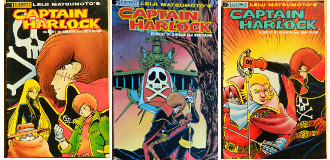
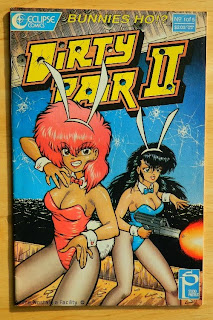




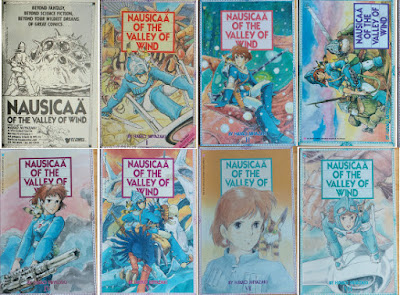
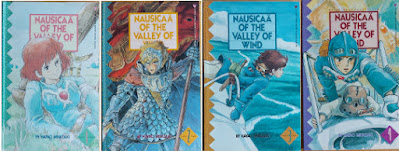






















.JPG)


